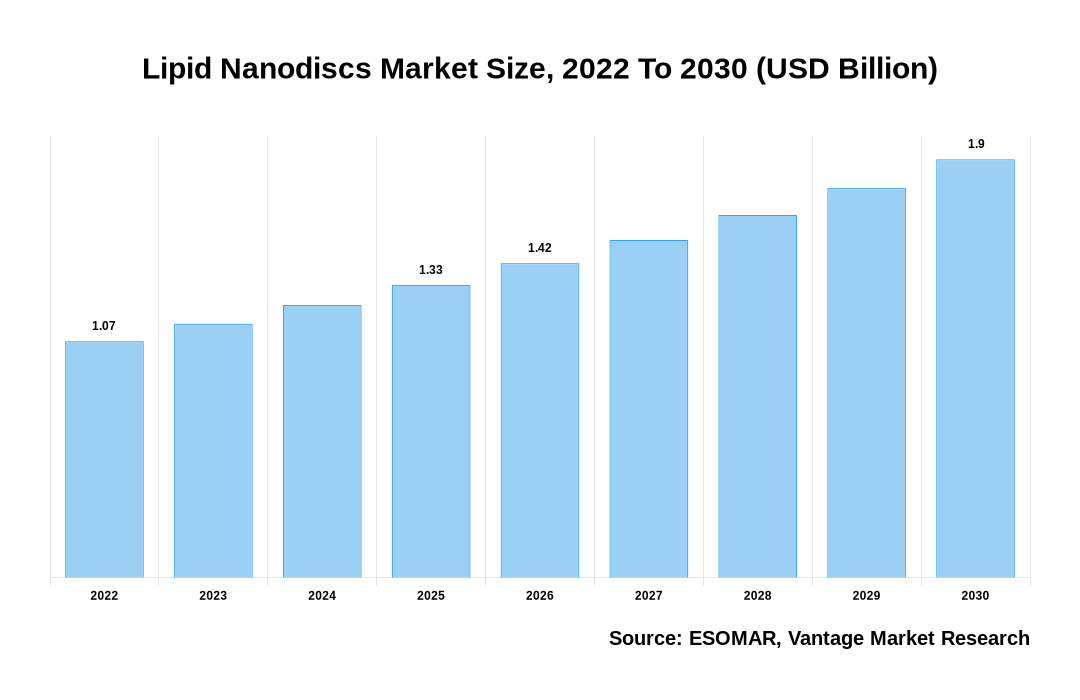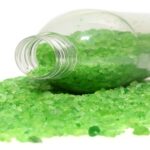Global Lipid Nanodiscs Market
As stated in our extensive report; the Global Lipid Nanodiscs Market accounted for USD 1.1 Billion in the year 2021.
Large chemical molecules known as lipids are either closely related substances or derivatives of fatty acids. Lipids are frequently more easily dissolved in alcohols and other organic solvents than in water. Because it provides sturdy membrane proteins with a home, nanodisc technology (NDT) has recently grown in popularity as a useful tool for biochemical and molecular model systems of membrane proteins. In the upcoming years, market growth is anticipated to be driven by rising consumer demand for lipids as a nutritional supplement, increased customer awareness of improving their health, and altered eating habits because of busy lifestyles.
Throughout the forecast period, the market is anticipated to be driven by the product’s significant impact on treating chronic illnesses like diabetes, cancer, cystic fibrosis, asthma, and arthritis. One of the key factors anticipated to drive market revenue growth is emerging research in phospholipid nanodiscs, which are known to develop a native-like membrane environment and make it easier to prepare biologically active folded forms of integral membrane proteins needed for structural research and examination of membrane proteins.

Click To Get a Free Sample On the Research Study
Key factors influencing Lipid Nanodiscs Market Growth
The growth of the global Lipid Nanodiscs market can be attributable to the following:
- Since it provides a home for resilient membrane proteins, nanodisc technology (NDT) has recently gained popularity as a useful tool for biochemical and molecular model systems of membrane proteins. They have also been widely used in the isolation, purification, and solubilization of membrane proteins for preparative and analytical procedures. This is explained by their intention to produce a phospholipid bilayer that, for target substances, replicates the natural phospholipid bilayer of cells (often membrane proteins).
- In order to mimic the amphipathic environment of a lipid bilayer and maintain the membrane protein structure in a physiologically relevant manner, membrane proteins must be made more soluble.
- Nanodiscs can help with this. PG, PE, and PIPs, or biotinylated lipids for adherence to avidin-modified glass slides, are the most often used synthetic lipids for Nanodisc assembly. Nanodiscs have been successfully constructed using a variety of synthetic lipids.
- Since they offer a bilayer surface with a predetermined composition and structure, nanodiscs have been very helpful in studying cellular signaling groups that assemble on membrane surfaces.
- The transport of substances, including amphipathic medications, therapeutic lipids, anchoring nucleic acids, imaging agents, and active protein complexes in vivo, is facilitated by nanodiscs and nanometer-scale vesicles.
- Additionally, they enable the production of a stable library of soluble nanoparticles that precisely replicate the membrane proteome, making them valuable for high-throughput screening and diagnostic applications. Nanodiscs are a promising tool for therapeutic treatments, drug discovery, and other biotechnological applications because they are also biocompatible.
- The growing scientific interest in phospholipid nanodiscs, which are known to create a native-like membrane environment and make it easier to prepare biologically active-folded forms of integral membrane proteins needed for structural research and membrane protein investigation, is one of the main factors anticipated to drive market revenue growth.
- The scientific community has paid close attention to these phospho-lipid bilayer nanodiscs as stable and programmable membrane mimics for researching membrane proteins.
- The implanted membrane protein can be studied structurally within the nanodiscs using high-resolution structural techniques, and its activity and interactions with other proteins in membrane-like environments can be evaluated using solution biochemical-biophysical techniques.
- The growing advantages of Nanodisctechnology over conventional integral membrane proteins for the manufacturing of commercial pharmaceutical medicines are another factor that is anticipated to fuel market revenue growth.
- Membrane proteins are excellent prospects for creating new treatments because they play a critical role in various biological processes, including signal transduction, transport, and enzymes in various metabolic pathways. Up to 30% of the human proteome is made up of integral membrane proteins, which make up more than half of all commercially marketed pharmacological targets.
- The task of finding inhibitors, activators, and specific antibodies using denatured or detergent-solubilized receptors, transporters, enzymes, and viral antigens soluble in aqueous solutions in a native-like bilayer environment that maintains the target function is one that researchers are frequently faced with because membrane proteins are typically difficult to examine using conventional methods.
- The ability of membrane proteins in Nanodiscs to cling to a surface without being denatured is another advantage of this platform, opening up a variety of sensing applications. The interaction via a histidine tag or a genetically modified or chemically altered site on the MSP belt, for example, can all be used sometimes to retain a membrane protein in its native bilayer environment but within close proximity to an electrode or sensor surface without affecting activity.
- Another example is the adsorption of Nanodisc on mica surfaces. These characteristics are advantageous for surface methods like surface plasmon resonance, localized plasmon approaches, and single-molecule research.
North America Region to Lead the Market
North America Lipid Nanodiscs market is getting more significant with maximum market share during the forecast period. Increased spending on R&D, new biotechnology start-ups using nanodisc platforms, the presence of numerous research organizations, and collaborations with important pharmaceutical corporations for nanodisc technologies are the main drivers of market expansion in this sector. Nanodisc technologies are being made available thanks to the presence of various research groups and partnerships with significant pharmaceutical corporations. In addition, government-funded research programs, an increase in the number of studies using nanodisc technology, and increased government financing for R&D activities are some of the major factors boosting market expansion in the region.
Conclusion
Rising consumer demand for lipids as a nutritional supplement increased customer awareness of improving their health, and altered eating habits due to busy lifestyles positively influenced the overall Lipid Nanodiscs market.
Some of the key players in the Global Lipid Nanodiscs Market include- Merck KGaA (Germany), Cube Biotech (Germany), Anatrace Products, LLC (U.S.), ideXLab (Paris), MEMPRO USA LTD (U.S.), Nano Temper (U.S.) and others.
![[Market Research Reports] – Research Google News Blog | VMR.Biz](https://www.vmr.biz/wp-content/uploads/2022/12/logo-removebg-preview.png)











